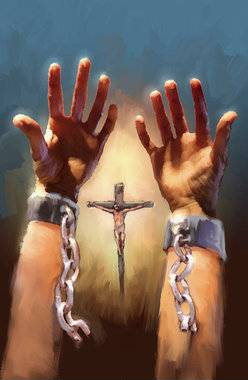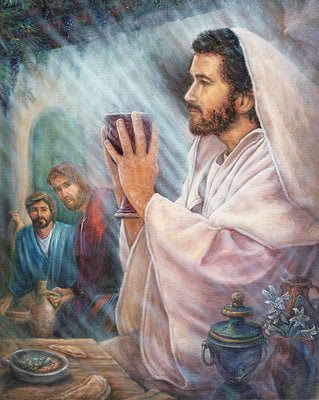Terça-feira, 22 de Fevereiro

3. Como é descrito o sacrifício de Jesus nestas passagens? Hebreus 7:27; 10:10
Os sacerdotes levitas – que tinham de ser “em grande número, porque pela morte foram impedidos de permanecer” (Hebreus 7:23) – são comparados a Jesus, que vive para sempre e tem um sacerdócio imutável (Hebreus 7:24, 25). Os sacerdotes levitas “cada dia” (Hebreus 7:27) e “cada ano” (Hebreus 9:25) ofereciam “dons e sacrifícios que, quanto à consciência, não podem aperfeiçoar aquele que faz o serviço” (Hebreus 9:9; 10:1-4).
Mas Jesus ofereceu-Se “uma vez”, “um único sacrifício” (Hebreus 10:10, 12-14) que purifica a nossa consciência (Hebreus 9:14; 10:1-10) e aniquila o pecado (Hebreus 9:26). O Seu sacrifício é superior ao de animais, porque Ele era o Filho de Deus (Hebreus 7:26-28), que cumpriu perfeitamente a vontade do Pai (Hebreus 10:5-10).
A descrição do sacrifício de Jesus como tendo sido “feita uma vez.” tem várias implicações importantes.
Primeiro, o Seu sacrifício é eficaz e nunca será superado. Os sacrifícios dos sacerdotes levitas eram repetidos porque não eram eficazes; caso contrário, “Doutra maneira, teriam deixado de se oferecer, porque, purificados uma vez os ministrantes, nunca mais teriam consciência de pecado” (Hebreus 10:2).
Em segundo lugar, os diferentes tipos de sacrifícios do Velho Testamento cumpriram-se na cruz. Jesus não só nos purifica do pecado (Hebreus 9:14), mas provê santificação (Hebreus 10:10-14) ao afastar o pecado de nós (Hebreus 9:26). Antes que os sacerdotes se aproximassem de Deus no santuário e ministrassem a favor dos seus semelhantes, eles tinham que ser limpos e santificados, ou consagrados (Levítico 8; 9). O sacrifício de Jesus limpa-nos e consagra-nos (Hebreus 10:10-14) para que possamos aproximar-nos de Deus com confiança (Hebreus 10:19-23) e servi-Lo como “sacerdócio real” (Hebreus 9:14; 1 Pedro 2:9).
O sacrifício de Jesus também alimenta a nossa vida espiritual; oferece um exemplo que precisamos seguir. Hebreus convida-nos a fixar os olhos em Jesus, especialmente nos eventos da cruz, e seguir a Sua liderança (Hebreus 12: 1-4; 13:12, 13).
A cruz é a base de todos os benefícios divinos: purificação do pecado, santificação para servir e alimento para crescer. Como podemos desfrutar o que recebemos de Jesus Cristo?
Quarta-feira, 23 de Fevereiro

4. O que é dito sobre a obra de Cristo no santuário celestial? Hebreus 9:22-28
A ideia de que o santuário celestial precisava ser purificado fazia sentido no contexto do santuário do Velho Testamento, que é um símbolo do governo divino (1 Samuel 4:4; 2 Samuel 6:2), e a maneira como Deus lida com o pecado do Seu povo afecta a percepção da justiça do Seu governo (Salmos 97:2). Sendo Governante, Deus é o Juiz do Seu povo e espera-se que Ele seja justo, vindicando os inocentes e condenando os culpados. Portanto, quando perdoa o pecador, Ele carrega a responsabilidade judicial. O santuário, que representa o carácter e o governo divinos, está contaminado, pois Deus carrega os nossos pecados quando nos perdoa (Êxodo 34:7; Números 14:17-19, a palavra hebraica original para “perdoar” [nose’] nestes versos significa “carregar, suportar”).
O sistema de sacrifícios no santuário israelita ilustra este ponto. Quando alguém procurava perdão, trazia um animal como sacrifício em seu favor, confessava os seus pecados sobre ele e matava-o. O sangue era borrifado nas pontas do altar ou aspergido diante do véu do templo no primeiro compartimento. Desta maneira, o pecado era transferido simbolicamente para o santuário. Deus carregava os pecados do povo.
No sistema israelita, a purificação ou expiação dos pecados acontecia em duas etapas. Durante o ano, os pecadores arrependidos traziam sacrifícios para o santuário. Estes sacrifícios purificavam as pessoas dos seus pecados e os transferiam para o santuário, para o próprio Deus. No fim do ano, no Dia da Expiação, que era o dia do juízo, Deus purificava o santuário, libertando a Sua responsabilidade judicial ao transferir os pecados para o bode expiatório, Azazel, que representava Satanás (Levítico 16:15-22).
Este sistema de duas fases, representadas pelos dois compartimentos no santuário terrestre, modelo do santuário celestial (Êxodo 25:9; Hebreus 8:5), permitia que Deus mostrasse misericórdia e justiça ao mesmo tempo. Quem confessava os pecados durante o ano mostrava lealdade a Deus observando um descanso solene e afligindo-se no Dia da Expiação (Levítico 16:29-31). Aqueles que não mostravam lealdade eram eliminados (Levítico 23:27-32).
Pense no que enfrentaria se tivesse que receber o castigo justo pelos seus pecados. Como é que isto o ajuda a entender o que Cristo fez por si?
Quinta-feira, 24 de Fevereiro

5. Leia Romanos 3:21-26; 1:16, 17 e 5:8. O que revela a redenção na cruz, para o perdão dos nossos pecados, sobre Deus?
O perdão dos pecados envolve duas fases na mediação de Jesus nos dois compartimentos do santuário celestial. Primeiro, Jesus removeu os nossos pecados e carregou-os na cruz para oferecer perdão a todos que crerem Nele (Atos 2:38; 5:31). Ele também inaugurou uma nova aliança, que Lhe permite pôr a lei de Deus no coração dos crentes através do Espírito Santo (Hebreus 8:10-12; Ezequiel 36:25-27).
A segunda fase deste ministério consiste num juízo, o juízo pré-advento, que ainda estava no futuro do ponto de vista de Hebreus (Hebreus 2:1-4; 6:2; 9:27, 28; 10:25). Este juízo começa com o povo de Deus e é descrito em Daniel 7:9-27, Mateus 22:1-14 e Apocalipse 14:7. O seu propósito é mostrar a justiça de Deus ao perdoar o Seu povo. Nele, o registo da vida de cada um será aberto ao Universo. O Juiz mostrará o que aconteceu no coração dos crentes, como aceitaram Jesus como Salvador e o Seu Espírito na vida.
Ao falar sobre este juízo, Ellen G. White escreveu: “Não pode o homem por si mesmo defender-se destas acusações. Em suas vestes manchadas de pecado, confessando a sua culpa, ei-lo perante Deus. Mas Jesus, o nosso Advogado, apresenta um eficaz rogo em favor de todos os que, mediante arrependimento e fé, a Ele confiaram a guarda da sua vida. Defende-lhes a causa e derrota o seu acusador, com os poderosos argumentos do Calvário. A Sua perfeita obediência à lei de Deus, mesmo até à morte de cruz, conferiu-Lhe todo o poder no Céu e na Terra, e Ele pleiteia do Seu Pai misericórdia e reconciliação para o homem culpado. [...] Mas, conquanto devamos reconhecer o nosso estado pecaminoso, temos de confiar em Cristo como nossa justiça, nossa santificação e redenção. Não podemos contestar as acusações de Satanás contra nós. Cristo, unicamente, pode pleitear eficazmente em nosso favor. Ele é capaz de silenciar o acusador com argumentos baseados não nos nossos méritos mas nos Seus” (Testemunhos Para a Igreja, v. 5, p. 470, 471).
Porque é que a cruz e o ministério de Jesus em nosso favor sugerem que olhemos para o juízo com confiança, mas com humildade e arrependimento?
Sexta-feira, 25 de Fevereiro

Estudo Adicional
Leia de Ellen G. White: “O Calvário”, p. 524-535 e “Está Consumado”, p. 537-542, em O Desejado de Todas as Nações.
Jiri Moskala explicou a natureza do juízo pré-advento. Deus “não vai exibir os meus pecados como na vitrine de uma loja. Antes de tudo, vai apontar para a Sua incrível graça transformadora e, diante do Universo, como a verdadeira Testemunha da minha vida, Ele vai explicar a minha atitude, os meus motivos, o meu pensamento, as minhas ações, a minha orientação e direção de vida. Jesus vai testificar que cometi erros, transgredi a Sua lei, mas arrependi-me, pedi perdão e fui transformado pela Sua graça. Ele proclamará: ‘O Meu sangue é suficiente para o pecador Moskala, a sua orientação de vida está em Mim, a sua atitude em relação a Mim e às pessoas é calorosa e altruísta, ele é confiável, ele é o Meu servo bom e fiel’” (Toward a Biblical Theology of God’s Judgment: A Celebration of the Cross in Seven Phases of Divine Universal Judgment, [Journal of the Adventist Theological Society 15, 2004], p. 155).
“Mas os seres remidos e os não caídos encontrarão na cruz de Cristo sua ciência e seu cântico. Ver-se-á que a glória que resplandece na face de Jesus Cristo é a glória do abnegado amor. À luz do Calvário se patenteará que a lei do amor que renuncia é a lei da vida para a Terra e o Céu; que o amor que “não busca os seus interesses” (1 Coríntios 13:5) tem sua fonte no coração de Deus; e que no manso e humilde Jesus se manifesta o caráter dAquele que habita na luz inacessível ao homem.” Ellen G. White, O Desejado de Todas as Nações, p. 9
Perguntas para Discussão:
1. Há uma tendência de oferecer sacrifícios em troca de salvação (actos de penitência, serviço ou auto-privação). Como é que estas práticas devem ser vistas à luz do sacrifício de Jesus e do facto de que a cruz pôs fim a todos os sacrifícios (Daniel 9:27; Hebreus 10:18)?
2. Qual é o papel do sacrifício do cristão? Jesus disse que precisamos tomar a nossa cruz e segui-Lo (Mateus 16:24); Paulo disse que devemos oferecer o corpo em “sacrifício vivo” (Romanos 12:1). Qual é a relação entre estas instruções e Hebreus 13:15, 16?























